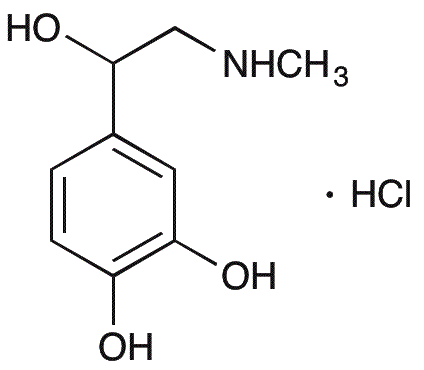(±)-Epinephrine hydrochloride is widely utilized in research focused on
- Medical Emergencies: Commonly used in emergency medicine, it is administered to treat severe allergic reactions (anaphylaxis) and cardiac arrest, providing rapid relief and restoring heart function.
- Respiratory Treatments: Inhaled formulations are effective for asthma management, helping to open airways and improve breathing in patients experiencing acute asthma attacks.
- Research Applications: Utilized in pharmacological studies to understand adrenergic receptor functions, aiding researchers in drug development and testing for various cardiovascular and respiratory conditions.
- Cosmetic Industry: Incorporated in some skincare products for its vasoconstrictive properties, helping to reduce redness and improve the appearance of skin during treatments.
- Veterinary Medicine: Used in veterinary practices to treat anaphylactic shock and other critical conditions in animals, ensuring rapid intervention and care in emergencies.
General Information
Properties
Safety and Regulations
Applications
(±)-Epinephrine hydrochloride is widely utilized in research focused on
- Medical Emergencies: Commonly used in emergency medicine, it is administered to treat severe allergic reactions (anaphylaxis) and cardiac arrest, providing rapid relief and restoring heart function.
- Respiratory Treatments: Inhaled formulations are effective for asthma management, helping to open airways and improve breathing in patients experiencing acute asthma attacks.
- Research Applications: Utilized in pharmacological studies to understand adrenergic receptor functions, aiding researchers in drug development and testing for various cardiovascular and respiratory conditions.
- Cosmetic Industry: Incorporated in some skincare products for its vasoconstrictive properties, helping to reduce redness and improve the appearance of skin during treatments.
- Veterinary Medicine: Used in veterinary practices to treat anaphylactic shock and other critical conditions in animals, ensuring rapid intervention and care in emergencies.
Documents
Safety Data Sheets (SDS)
The SDS provides comprehensive safety information on handling, storage, and disposal of the product.
Product Specification (PS)
The PS provides a comprehensive breakdown of the product’s properties, including chemical composition, physical state, purity, and storage requirements. It also details acceptable quality ranges and the product's intended applications.
Certificates of Analysis (COA)
Search for Certificates of Analysis (COA) by entering the products Lot Number. Lot and Batch Numbers can be found on a product’s label following the words ‘Lot’ or ‘Batch’.
*Catalog Number
*Lot Number
Certificates Of Origin (COO)
This COO confirms the country where the product was manufactured, and also details the materials and components used in it and whether it is derived from natural, synthetic, or other specific sources. This certificate may be required for customs, trade, and regulatory compliance.
*Catalog Number
*Lot Number
Safety Data Sheets (SDS)
The SDS provides comprehensive safety information on handling, storage, and disposal of the product.
DownloadProduct Specification (PS)
The PS provides a comprehensive breakdown of the product’s properties, including chemical composition, physical state, purity, and storage requirements. It also details acceptable quality ranges and the product's intended applications.
DownloadCertificates of Analysis (COA)
Search for Certificates of Analysis (COA) by entering the products Lot Number. Lot and Batch Numbers can be found on a product’s label following the words ‘Lot’ or ‘Batch’.
*Catalog Number
*Lot Number
Certificates Of Origin (COO)
This COO confirms the country where the product was manufactured, and also details the materials and components used in it and whether it is derived from natural, synthetic, or other specific sources. This certificate may be required for customs, trade, and regulatory compliance.


